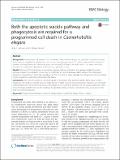| dc.contributor.author | Johnsen, Holly L. | |
| dc.contributor.author | Horvitz, Howard Robert | |
| dc.date.accessioned | 2016-06-24T22:53:54Z | |
| dc.date.available | 2016-06-24T22:53:54Z | |
| dc.date.issued | 2016-05 | |
| dc.date.submitted | 2016-03 | |
| dc.identifier.issn | 1741-7007 | |
| dc.identifier.uri | http://hdl.handle.net/1721.1/103348 | |
| dc.description.abstract | Background
Programmed cell deaths in the nematode Caenorhabditis elegans are generally considered suicides. Dying cells are engulfed by neighboring cells in a process of phagocytosis. To better understand the interaction between the engulfment and death processes, we analyzed B.al/rapaav cell death, which has been previously described as engulfment-dependent and hence as a possible murder.
Results
We found that B.al/rapaav is resistant to caspase-pathway activation: the caspase-mediated suicide pathway initiates the cell-death process but is insufficient to cause B.al/rapaav death without the subsequent assistance of engulfment. When the engulfing cell P12.pa is absent, other typically non-phagocytic cells can display cryptic engulfment potential and facilitate this death.
Conclusions
We term this death an “assisted suicide” and propose that assisted suicides likely occur in other organisms. The study of assisted suicides might provide insight into non-cell autonomous influences on cell death. Understanding the mechanism that causes B.al/rapaav to be resistant to activation of the caspase pathway might reveal the basis of differences in the sensitivity to apoptotic stimuli of tumor and normal cells, a key issue in the field of cancer therapeutics. | en_US |
| dc.description.sponsorship | Howard Hughes Medical Institute | en_US |
| dc.description.sponsorship | National Institutes of Health (U.S.) (Pre-Doctoral Training Grant T32GM007287) | en_US |
| dc.publisher | BioMed Central | en_US |
| dc.relation.isversionof | http://dx.doi.org/10.1186/s12915-016-0262-5 | en_US |
| dc.rights | Creative Commons Attribution | en_US |
| dc.rights.uri | http://creativecommons.org/licenses/by/4.0/ | en_US |
| dc.source | BioMed Central | en_US |
| dc.title | Both the apoptotic suicide pathway and phagocytosis are required for a programmed cell death in Caenorhabditis elegans | en_US |
| dc.type | Article | en_US |
| dc.identifier.citation | Johnsen, Holly L., and H. Robert Horvitz. “Both the Apoptotic Suicide Pathway and Phagocytosis Are Required for a Programmed Cell Death in Caenorhabditis Elegans.” BMC Biology 14.1 (2016): n. pag. | en_US |
| dc.contributor.department | Massachusetts Institute of Technology. Department of Biology | en_US |
| dc.contributor.mitauthor | Horvitz, H. Robert | en_US |
| dc.contributor.mitauthor | Johnsen, Holly L. | en_US |
| dc.relation.journal | BMC Biology | en_US |
| dc.eprint.version | Final published version | en_US |
| dc.type.uri | http://purl.org/eprint/type/JournalArticle | en_US |
| eprint.status | http://purl.org/eprint/status/PeerReviewed | en_US |
| dc.date.updated | 2016-05-17T03:31:16Z | |
| dc.language.rfc3066 | en | |
| dc.rights.holder | Johnsen and Horvitz. | |
| dspace.orderedauthors | Johnsen, Holly L.; Horvitz, H. Robert | en_US |
| dspace.embargo.terms | N | en_US |
| dc.identifier.orcid | https://orcid.org/0000-0002-9840-4112 | |
| dc.identifier.orcid | https://orcid.org/0000-0002-9964-9613 | |
| mit.license | PUBLISHER_CC | en_US |
